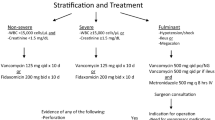Abstract
PURPOSE: Reports of fatality related to Clostridium difficile colitis and a sharp increase in prevalence of this infection prompted a study of patients who develop a more aggressive form of this disease. METHODS: Over 38 months, 710 patients at our institution developed C. difficile colitis. Twenty-one (3 percent) of these patients either required intensive care unit admission or died as a result of their infection. A retrospective, case-controlled study was undertaken to compare these patients, who were considered to have severe C. difficile colitis, with the remaining patients with milder disease. RESULTS: Factors that predisposed to the development of severe C. difficile colitis included intercurrent malignancy, chronic obstructive pulmonary disease, immunosuppressive and antiperistaltic medications, renal failure, and administration of clindamycin (P<0.05 for all). Patients with severe C. difficile colitis were more likely to have abdominal pain, tenderness and distention, peritonitis, hemoconcentration (>5 points), hypoalbuminemia (<3 mg/dl), and elevated or suppressed white blood cell count (>25,000; <1,500;P<0.05 for all). These factors were used to create a scoring system that could distinguish between patients with severe C. difficile colitis and those with mild disease. Thirteen patients in the late stages of terminal illness with metastatic malignancy or age >90 were considered poor or inappropriate surgical candidates. Only the remaining eight patients could have potentially recovered from operation with hope for long-term survival. Of these, seven were treated without colonic resection, and six of the seven survived, whereas one patient underwent colectomy and did not survive. CONCLUSIONS: Patients with severe C. difficile colitis can be readily identified. Often they have coexisting illness that precludes operation. In this series, only 1 of 21 patients with severe C. difficile might have benefited from an aggressive surgical approach.
Similar content being viewed by others
References
Pothoulakis C, LaMont JT. Clostridium difficile colitis and diarrhea. Gastroenterol Clin North Am 1993;22:623–37.
Bartlett JG, Onderdonk AB, Cisneros RL. Clindamycin associated colitis due to a toxin producing species of clostridium in hamsters. J Infect Dis 1977;136:701–5.
Medich DS, Lee KK, Simmons RL, Grubbs PJ, Yang HC, Showalter DP. Laparotomy for fulminant pseudomembranous colitis. Arch Surg 1992;127:847–53.
Morris JB, Zollinger RM, Stellato TA. Role of surgery in antibiotic induced pseudomembranous enterocolitis. Am J Surg 1990;160:535–9.
Waddel TK, McLeod RS, Rotstein OD, Cohen Z. Surgical management of fulminant pseudomembranous colitis. Can J Surg 1992;35:555–9.
Author information
Authors and Affiliations
Additional information
Read at the meeting of The American Society of Colon and Rectal Surgeons, Orlando, Florida, May 8 to 13, 1994.
About this article
Cite this article
Rubin, M.S., Bodenstein, L.E. & Kent, K.C. SevereClostridium difficile colitis. Dis Colon Rectum 38, 350–354 (1995). https://doi.org/10.1007/BF02054220
Issue Date:
DOI: https://doi.org/10.1007/BF02054220




